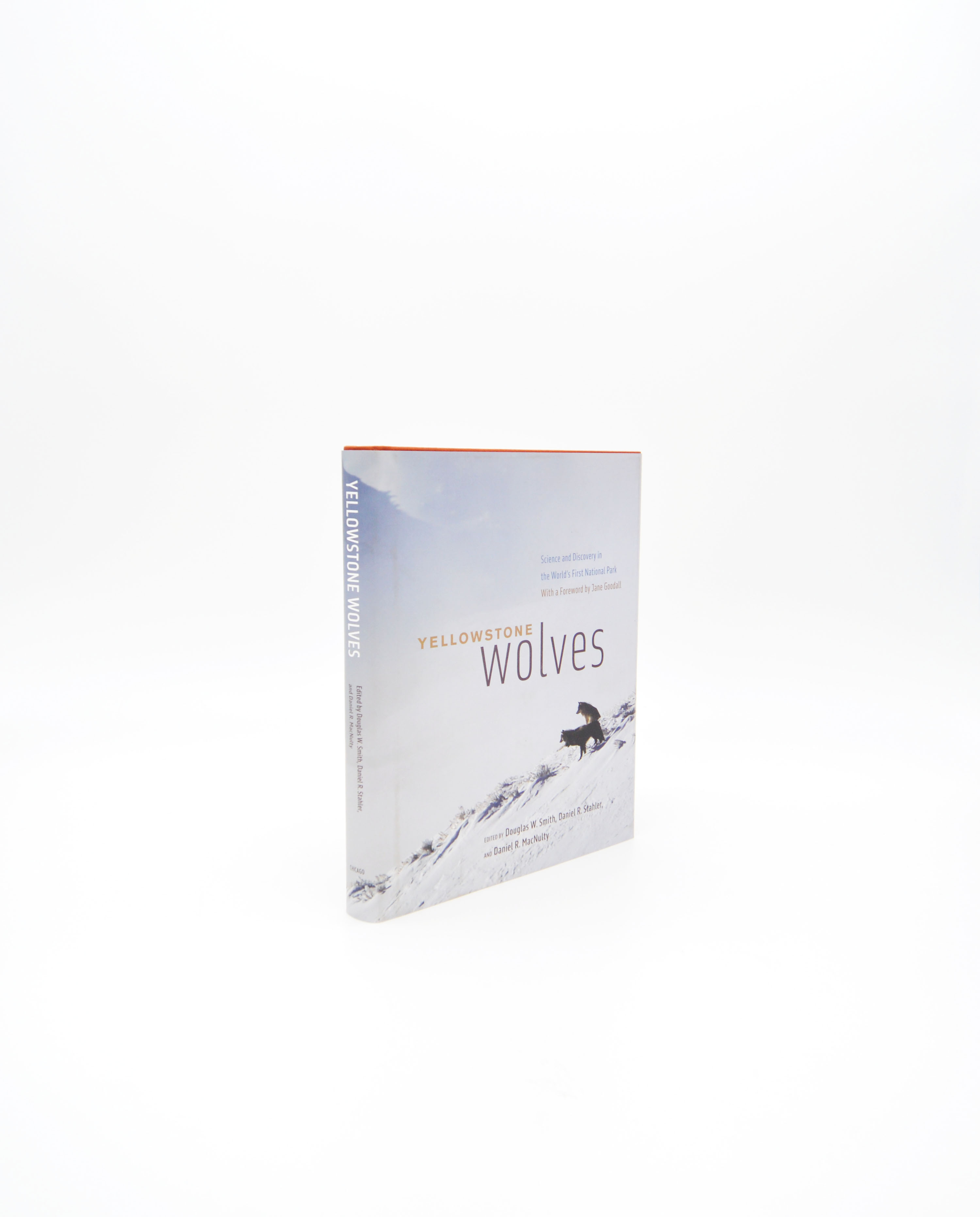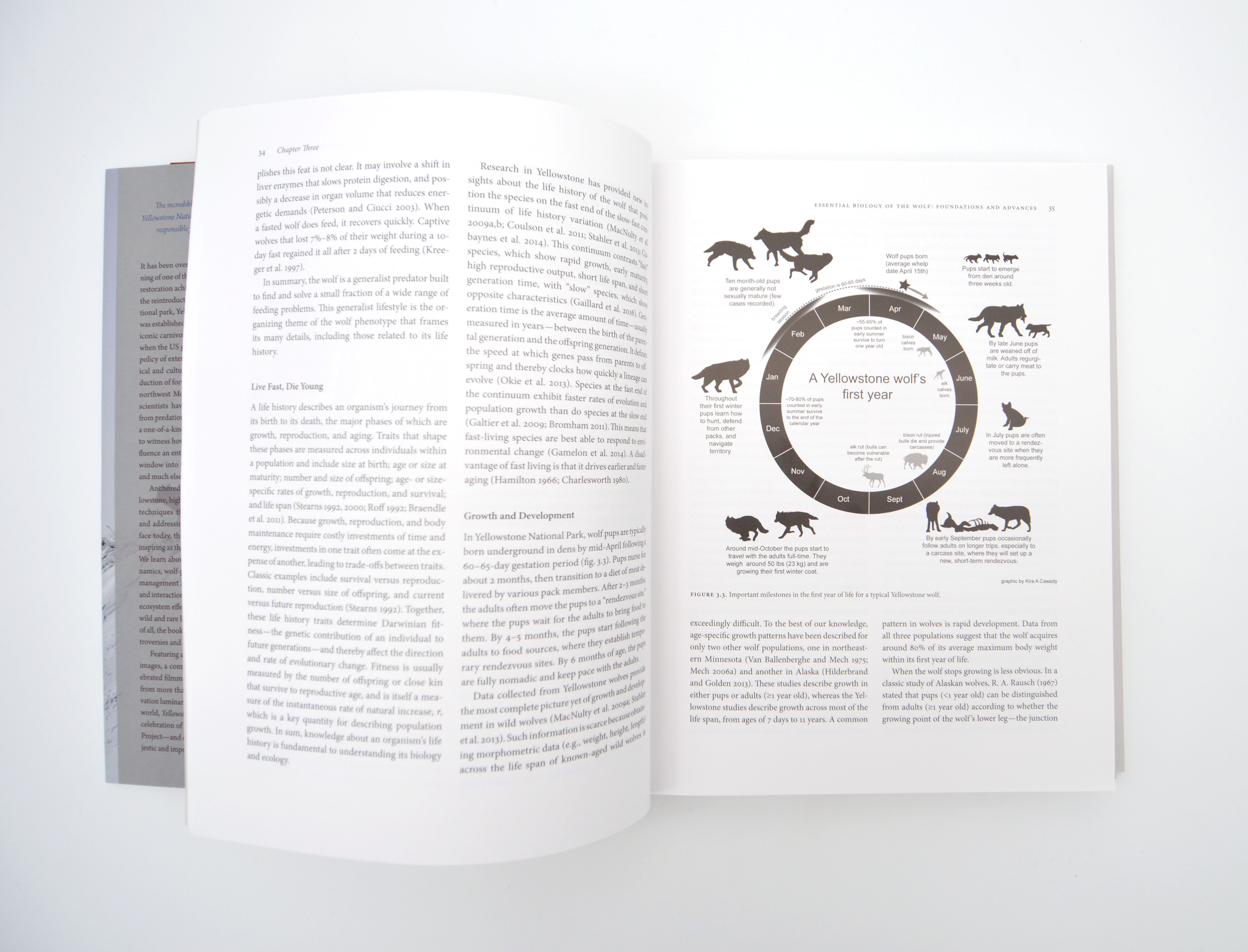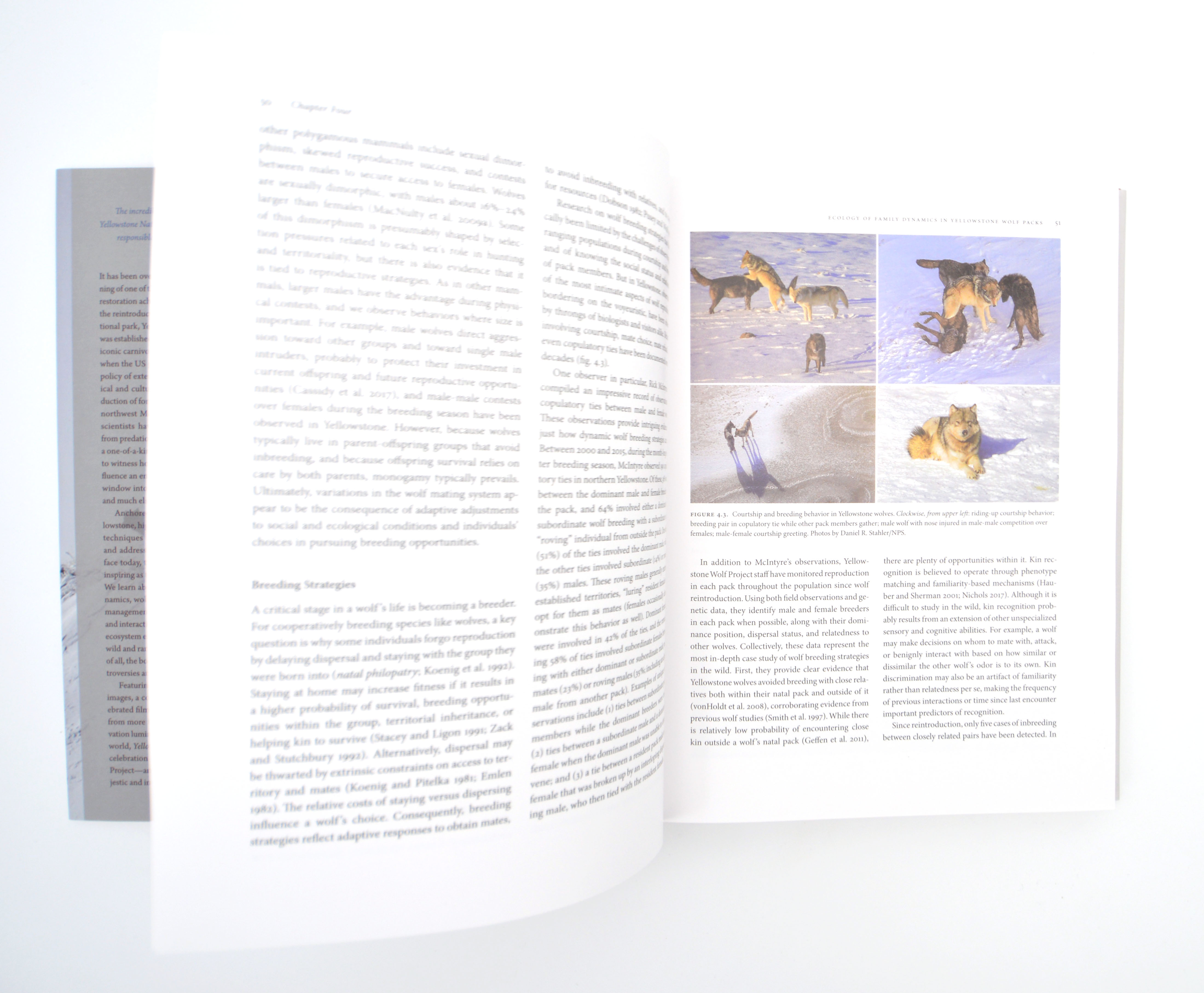Yellowstone Wolves
Science and Discovery in the World’s First National Park
9780226728346
9780226728483
Yellowstone Wolves
Science and Discovery in the World’s First National Park
In 2020, it will have been twenty-five years since one of the greatest wildlife conservation and restoration achievements of the twentieth century took place: the reintroduction of wolves to the world’s first national park, Yellowstone. Eradicated after the park was established, then absent for seventy years, these iconic carnivores returned to Yellowstone in 1995 when the US government reversed its century-old policy of extermination and—despite some political and cultural opposition—began the reintroduction of forty-one wild wolves from Canada and northwest Montana. In the intervening decades, scientists have studied their myriad behaviors, from predation to mating to wolf pup play, building a one-of-a-kind field study that has both allowed us to witness how the arrival of top predators can change an entire ecosystem and provided a critical window into impacts on prey, pack composition, and much else.
Here, for the first time in a single book, is the incredible story of the wolves’ return to Yellowstone National Park as told by the very people responsible for their reintroduction, study, and management. Anchored in what we have learned from Yellowstone, highlighting the unique blend of research techniques that have given us this knowledge, and addressing the major issues that wolves still face today, this book is as wide-ranging and awe-inspiring as the Yellowstone restoration effort itself. We learn about individual wolves, population dynamics, wolf-prey relationships, genetics, disease, management and policy, newly studied behaviors and interactions with other species, and the rippling ecosystem effects wolves have had on Yellowstone’s wild and rare landscape. Perhaps most importantly of all, the book also offers solutions to ongoing controversies and debates.
Featuring a foreword by Jane Goodall, beautiful images, a companion online documentary by celebrated filmmaker Bob Landis, and contributions from more than seventy wolf and wildlife conservation luminaries from Yellowstone and around the world, Yellowstone Wolves is a gripping, accessible celebration of the extraordinary Yellowstone Wolf Project—and of the park through which these majestic and important creatures once again roam.
Here, for the first time in a single book, is the incredible story of the wolves’ return to Yellowstone National Park as told by the very people responsible for their reintroduction, study, and management. Anchored in what we have learned from Yellowstone, highlighting the unique blend of research techniques that have given us this knowledge, and addressing the major issues that wolves still face today, this book is as wide-ranging and awe-inspiring as the Yellowstone restoration effort itself. We learn about individual wolves, population dynamics, wolf-prey relationships, genetics, disease, management and policy, newly studied behaviors and interactions with other species, and the rippling ecosystem effects wolves have had on Yellowstone’s wild and rare landscape. Perhaps most importantly of all, the book also offers solutions to ongoing controversies and debates.
Featuring a foreword by Jane Goodall, beautiful images, a companion online documentary by celebrated filmmaker Bob Landis, and contributions from more than seventy wolf and wildlife conservation luminaries from Yellowstone and around the world, Yellowstone Wolves is a gripping, accessible celebration of the extraordinary Yellowstone Wolf Project—and of the park through which these majestic and important creatures once again roam.
Purchasers of the book can access videos of the Yellowstone wolves and an interview with the author at this link.
344 pages | 62 color plates, 29 halftones, 24 line drawings | 8-1/2 x 11 | © 2020
Biological Sciences: Conservation, Ecology
Reviews
Table of Contents
Study Area Map
A Note on Accompanying Video
Robert K. Landis
Foreword
Jane Goodall
Preface
Douglas W. Smith, Daniel R. Stahler, and Daniel R. MacNulty
A Note on Accompanying Video
Robert K. Landis
Foreword
Jane Goodall
Preface
Douglas W. Smith, Daniel R. Stahler, and Daniel R. MacNulty
Part 1 History and Reintroduction
1 Historical and Ecological Context for Wolf Recovery
Douglas W. Smith, Daniel R. Stahler, Daniel R. MacNulty, and Lee H. Whittlesey
Box 1.1 Wolf History and Surveys in Yellowstone National Park
John Weaver
2 How Wolves Returned to Yellowstone
Steven H. Fritts, Rebecca J. Watters, Edward E. Bangs, Douglas W. Smith, and Michael K. Phillips
Box 2.1 To Reintroduce or Not to Reintroduce, That Is the Question
Diane Boyd
Guest Essay: Why Are Yellowstone Wolves Important?
L. David Mech
Part 2 Behavioral and Population Ecology
3 Essential Biology of the Wolf: Foundations and Advances
Daniel R. MacNulty, Daniel R. Stahler, Tim Coulson, and Douglas W. Smith
4 Ecology of Family Dynamics in Yellowstone Wolf Packs
Daniel R. Stahler, Douglas W. Smith, Kira A. Cassidy, Erin E. Stahler, Matthew C. Metz, Rick McIntyre, and Daniel R. MacNulty
Box 4.1 Naming Wolf Packs
Daniel R. Stahler
5 Territoriality and Competition between Wolf Packs
Kira A. Cassidy, Douglas W. Smith, Daniel R. Stahler, Daniel R. MacNulty, Erin E. Stahler, and Matthew C. Metz
Box 5.1 Auditory Profile: The Howl of the Wolf
John B. Theberge and Mary T. Theberge
John B. Theberge and Mary T. Theberge
6 Population Dynamics and Demography
Douglas W. Smith, Kira A. Cassidy, Daniel R. Stahler, Daniel R. MacNulty, Quinn Harrison, Ben Balmford, Erin E. Stahler, Ellen E. Brandell, and Tim Coulson
Guest Essay: Yellowstone Wolves Are Important Because They Changed Science
Rolf O. Peterson and Trevor S. Peterson
Part 3 Genetics and Disease
7 Yellowstone Wolves at the Frontiers of Genetic Research
Daniel R. Stahler, Bridgett M. vonHoldt, Elizabeth Heppenheimer, and Robert K. Wayne
8 The K Locus: Rise of the Black Wolf
Rena M. Schweizer, Daniel R. Stahler, Daniel R. MacNulty, Tim Coulson, Phil Hedrick, Rachel Johnston, Kira A. Cassidy, Bridgett M. vonHoldt, and Robert K. Wayne
9 Infectious Diseases in Yellowstone’s Wolves
Ellen E. Brandell, Emily S. Almberg, Paul C. Cross, Andrew P. Dobson, Douglas W. Smith, and Peter J. Hudson
Guest Essay: Why Are Yellowstone Wolves Important? A European Perspective
Olof Liberg
Part 4 Wolf-Prey Relationships
10 How We Study Wolf-Prey Relationships
Douglas W. Smith, Matthew C. Metz, Daniel R. Stahler, and Daniel R. MacNulty
Box 10.1 Nine-Three-Alpha
Douglas W. Smith
Douglas W. Smith
Box 10.2 The Bone Collectors
Ky Koitzsch and Lisa Koitzsch
Ky Koitzsch and Lisa Koitzsch
11 Limits to Wolf Predatory Performance
Daniel R. MacNulty, Daniel R. Stahler, and Douglas W. Smith
Box 11.1 Tougher Times for Yellowstone Wolves Reflected in Tooth Wear and Fracture
Blaire Van Valkenburgh
Blaire Van Valkenburgh
12 What Wolves Eat and Why
Matthew C. Metz, Mark Hebblewhite, Douglas W. Smith, Daniel R. Stahler, Daniel R. MacNulty, Aimee Tallian, and John A. Vucetich
Box 12.1 Bison in Wood Buffalo National Park
L. N. Carbyn
13 Wolf Predation on Elk in a Multi-Prey Environment
Matthew C. Metz, Douglas W. Smith, Daniel R. Stahler, Daniel R. MacNulty, and Mark Hebblewhite
Box 13.1 Generalizing Wolf-Prey Dynamics across Systems: Yellowstone, Banff, and Isle Royale
Mark Hebblewhite
Mark Hebblewhite
Box 13.2 The Predator’s Perspective: Biomass of Prey
Matthew C. Metz
Box 13.3 Lessons from Denali National Park: Stability in Predator-Prey Dynamics Is a Pause on the Way to Somewhere Else
Layne Adams
Matthew C. Metz
Box 13.3 Lessons from Denali National Park: Stability in Predator-Prey Dynamics Is a Pause on the Way to Somewhere Else
Layne Adams
14 Population Dynamics of Northern Yellowstone Elk after Wolf Reintroduction
Daniel R. MacNulty, Daniel R. Stahler, Travis Wyman, Joel Ruprecht, Lacy M. Smith, Michel T. Kohl, and Douglas W. Smith
Box 14.1 Wolves and Elk in the Madison Headwaters
Robert A. Garrott, P. J. White, Claire Gower, Matthew S. Becker, Shana Drimal, Ken L. Hamlin, and Fred G. R. Watson
Robert A. Garrott, P. J. White, Claire Gower, Matthew S. Becker, Shana Drimal, Ken L. Hamlin, and Fred G. R. Watson
Box 14.2 Ecology of Fear
Daniel R. Stahler and Daniel R. MacNulty
Daniel R. Stahler and Daniel R. MacNulty
Guest Essay: The Value of Yellowstone’s Wolves? The Power of Choice
Michael K. Phillips
Part 5 Ecosystem Effects and Species Interactions
15 Indirect Effects of Carnivore Restoration on Vegetation
Rolf O. Peterson, Robert L. Beschta, David J. Cooper, N. Thompson Hobbs, Danielle Bilyeu Johnston, Eric J. Larsen, Kristin N. Marshall, Luke E. Painter, William J. Ripple, Joshua R. Rose, Douglas W. Smith, and Evan C. Wolf
Box 15.1 Long-Term Trends in Beaver, Moose, and Willow Status in the Southern Portion of the Absaroka-Beartooth Wilderness
Daniel B. Tyers
Daniel B. Tyers
16 Competition and Coexistence among Yellowstone’s Meat Eaters
Daniel R. Stahler, Christopher C. Wilmers, Aimee Tallian, Colby B. Anton, Matthew C. Metz, Toni K. Ruth, Douglas W. Smith, Kerry A. Gunther, and Daniel R. MacNulty
Guest Essay: Old Dogs Taught Old Lessons
Paul C. Paquet
Part 6 Conservation, Management, and the Human Experience
17 Wolves and Humans in Yellowstone
Douglas W. Smith, Daniel R. Stahler, Rick McIntyre, Erin E. Stahler, and Kira A. Cassidy
18 The Wolf Watchers
Nathan Varley, Rick McIntyre, and James Halfpenny
Box 18.1 Bob Landis’s Yellowstone Wolves Documentaries 000
Box 18.2 Seeing Wolves
Robert Hayes
Box 18.2 Seeing Wolves
Robert Hayes
19 Conservation and Management: A Way Forward
Douglas W. Smith, P. J. White, Daniel R. Stahler, Rebecca J. Watters, Kira A. Cassidy, Adrian Wydeven, Jim Hammill, and David E. Hallac
Guest Essay: Making Better Sense of Wolves
Susan G. Clark
Afterword
Rebecca J. Watters, Douglas W. Smith, Daniel R. Stahler, and Daniel R. MacNulty
Acknowledgments
Appendix: Species Names Used in the Text
Literature Cited
List of Contributors
Author Index
Subject Index
Rebecca J. Watters, Douglas W. Smith, Daniel R. Stahler, and Daniel R. MacNulty
Acknowledgments
Appendix: Species Names Used in the Text
Literature Cited
List of Contributors
Author Index
Subject Index
Awards
The Wildlife Society: TWS Publication Award, Edited Collection
Won
The Wildlife Society: Wildlife Society Publications Award
Shortlist





